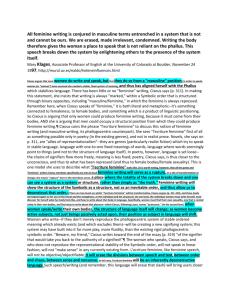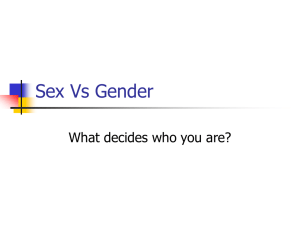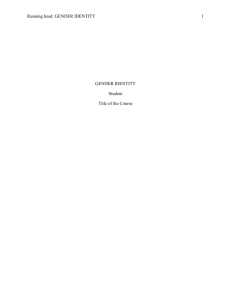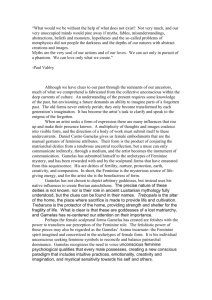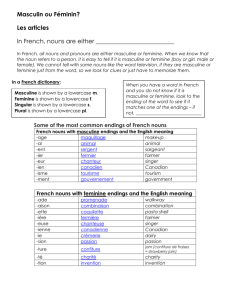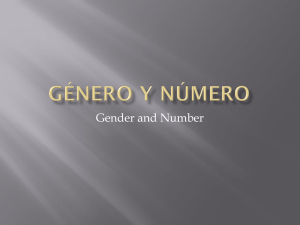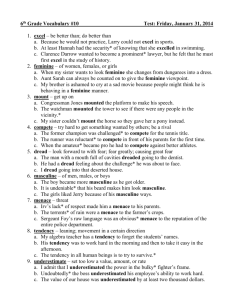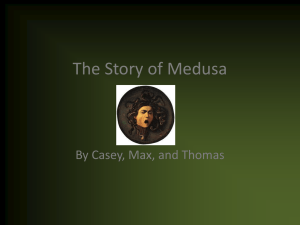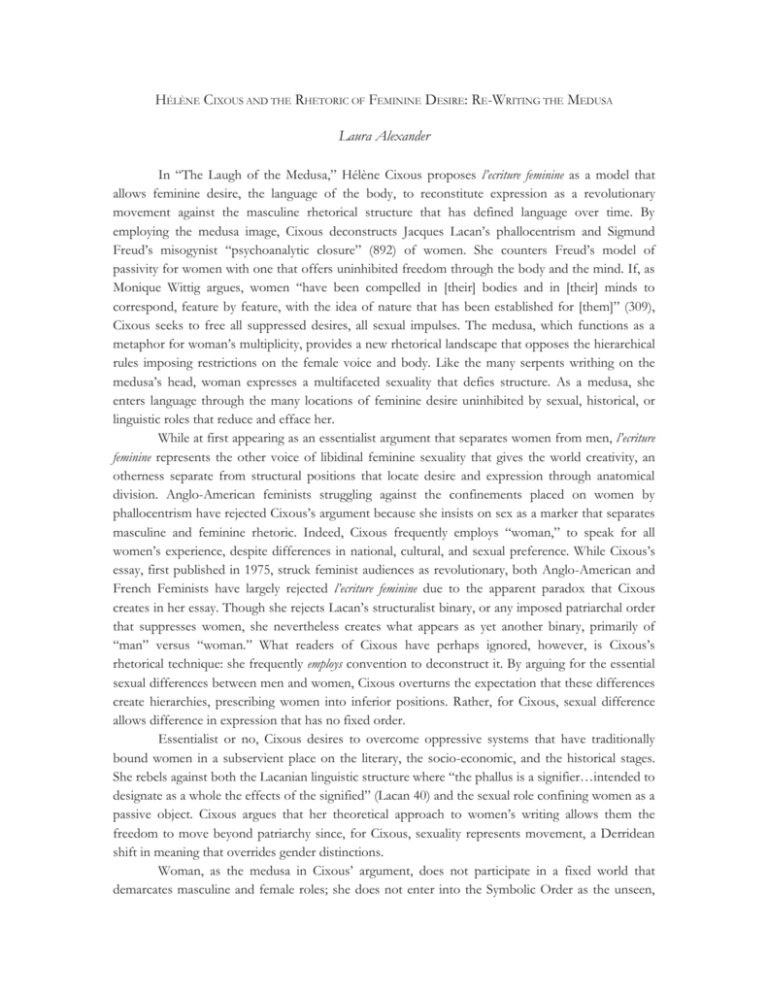
HÉLÈNE CIXOUS AND THE RHETORIC OF FEMININE DESIRE: RE-WRITING THE MEDUSA
Laura Alexander
In “The Laugh of the Medusa,” Hélène Cixous proposes l’ecriture feminine as a model that
allows feminine desire, the language of the body, to reconstitute expression as a revolutionary
movement against the masculine rhetorical structure that has defined language over time. By
employing the medusa image, Cixous deconstructs Jacques Lacan’s phallocentrism and Sigmund
Freud’s misogynist “psychoanalytic closure” (892) of women. She counters Freud’s model of
passivity for women with one that offers uninhibited freedom through the body and the mind. If, as
Monique Wittig argues, women “have been compelled in [their] bodies and in [their] minds to
correspond, feature by feature, with the idea of nature that has been established for [them]” (309),
Cixous seeks to free all suppressed desires, all sexual impulses. The medusa, which functions as a
metaphor for woman’s multiplicity, provides a new rhetorical landscape that opposes the hierarchical
rules imposing restrictions on the female voice and body. Like the many serpents writhing on the
medusa’s head, woman expresses a multifaceted sexuality that defies structure. As a medusa, she
enters language through the many locations of feminine desire uninhibited by sexual, historical, or
linguistic roles that reduce and efface her.
While at first appearing as an essentialist argument that separates women from men, l’ecriture
feminine represents the other voice of libidinal feminine sexuality that gives the world creativity, an
otherness separate from structural positions that locate desire and expression through anatomical
division. Anglo-American feminists struggling against the confinements placed on women by
phallocentrism have rejected Cixous’s argument because she insists on sex as a marker that separates
masculine and feminine rhetoric. Indeed, Cixous frequently employs “woman,” to speak for all
women’s experience, despite differences in national, cultural, and sexual preference. While Cixous’s
essay, first published in 1975, struck feminist audiences as revolutionary, both Anglo-American and
French Feminists have largely rejected l’ecriture feminine due to the apparent paradox that Cixous
creates in her essay. Though she rejects Lacan’s structuralist binary, or any imposed patriarchal order
that suppresses women, she nevertheless creates what appears as yet another binary, primarily of
“man” versus “woman.” What readers of Cixous have perhaps ignored, however, is Cixous’s
rhetorical technique: she frequently employs convention to deconstruct it. By arguing for the essential
sexual differences between men and women, Cixous overturns the expectation that these differences
create hierarchies, prescribing women into inferior positions. Rather, for Cixous, sexual difference
allows difference in expression that has no fixed order.
Essentialist or no, Cixous desires to overcome oppressive systems that have traditionally
bound women in a subservient place on the literary, the socio-economic, and the historical stages.
She rebels against both the Lacanian linguistic structure where “the phallus is a signifier…intended to
designate as a whole the effects of the signified” (Lacan 40) and the sexual role confining women as a
passive object. Cixous argues that her theoretical approach to women’s writing allows them the
freedom to move beyond patriarchy since, for Cixous, sexuality represents movement, a Derridean
shift in meaning that overrides gender distinctions.
Woman, as the medusa in Cixous’ argument, does not participate in a fixed world that
demarcates masculine and female roles; she does not enter into the Symbolic Order as the unseen,
unheard other. Rather, her fluid approach seeks to free women from any idea of structured social or
linguistic positions as locators for desire or expression. As contemporary French feminist Luce
Irigaray has suggested, the act of writing remains attached to the expression and manifestation of
woman’s many desires. Irigaray, like Cixous, invites woman to explore her sexuality as “plural” and
located “everywhere” (336) so that she may release herself and her many selves from a system that
objectifies women as sexual and linguistic commodities fixed by, written about, and traded among
men.
The metaphoric serpents moving freely from the medusa’s head correspond to Cixous’
theory of feminine writing as a discursive activity that rejects stabilized language and structuralism.
She identifies that woman writing woman and writing the body can represent the feminine only when
woman releases herself from the linguistic constraints of masculine oppression, from Lacan’s model
of phallic centered language.
Jacqueline Rose examines Lacan’s divisive framework for language employed by men and
women who “must line up according to an opposition (having or not having the phallus)” (29) to
emphasize the confining nature of Lacan’s Freudian language system. She provides a framework
from which we can understand the psychoanalytic closure that Cixous rebels against through
feminine writing. By arguing against closure and the castration complex, Cixous breaks away from an
oppressive mold and implies that the fluidity of feminine writing, like the female body, functions as
many parts of woman combined into one woman, through language, desire, and expression. This
fluidity, like the many snakes of the medusa, symbolizes “the wonder of being several” (890) in many
states—intellectual, carnal, psychological, and emotional—of infinite being. Once feminine
expression has shifted out of fixed parameters, and they are always shifting because slipperiness
defines woman’s sexuality in l’ecriture feminine, the phallus disappears in Cixous’ agenda for rewriting
the female body.
The purpose of this paper is to examine how feminine writing resists linguistic, historical, and
sexual confinements placed on women forced to enter language through a masculine rhetorical
economy. Because feminine writing represents expression not only as writing but also as lived
experience through the recreation of and through the body, I am focusing on Cixous’s model of a
multidimensional being free from the constraints imposed on her through time. By employing female
sexuality as a new feminine rhetoric, Cixous seeks to project expression through the image of the
medusa, which symbolizes both feminine writing and feminism as a cultural, political, and linguistic
movement. Just as the serpents on the medusa’s head reject the Freudian location of heterosexual
feminine desires as active to passive sexual desire, so too must the many female selves (the
metaphorical serpents unleashed) spread in diverse directions for fluid, feminine expression. She,
who possesses many desires, possesses many modes for these desires and many channels through
which her inner, subjected passions may mature, or rather, unfold. As Clara Juncker notes, Cixous’s
method invites woman to “write her body in order to discover herself. She must explore her
jouissance, her sexual pleasure, so as to bring down phallogocentric discourse and, ultimately, change
the world” (426).
Like the medusa that Cixous employs as the overarching figure in her essay, woman reaches
through many forms to cross gender barriers. Ultimately, she expresses her self, working alongside
rather than against her masculine counterpart, for an equal space free from the guilt, hate, and fear
Freud contrives as the relationship between men and women. These locations of desire constitute a
revolution in language and gender representation. Cheryl Glenn defines Cixous’s rhetorical strategy
as a “remapping” process that women who “write women” should undertake as they “continue to
resist received notions both of history and of writing history” (290).
By applying Cixous’s theoretical approach to Mary Barber’s eighteenth-century poem “To
Mrs. Frances-Arabella Kelly” as a study in how women have perceived themselves, one sees Glenn’s
“notions of history” emerge through the prescribed aesthetic and emotional agendas at work for
women. The speaker, a middle-aged woman, views her mature looks, particularly her gray hair, and
sees a medusa in the mirror, “the Gorgon’s head” (4), about whom all the “witty coxcombs cry, /
‘Rot that old witch—she’ll never die” (13-14). It is precisely this vision of the medusa as mythic
monster, as a woman whose “grizzled locks” (3) keep her bound in a world that fixes the meaning of
beauty, and subsequently, of personal worth, that l’ecriture feminine challenges. Cixous wants to refigure
the “mythic monster” Freud contrives into a woman, not an object to fear and hate. The medusa’s
glance does not metamorphose men into stone; she does not exist as a monster to be pitied, hated,
and scorned, as the speaker pities herself and the younger woman destined for her fate in the poem.
Cixous invites woman to think of the self as another kind of metaphorical medusa, able to express
the self in a myriad of regenerative forms. Furthermore, l’ecriture feminine, the language expressed
through the medusa image, encourages women to celebrate themselves, to write and live in a
deconstructed world without restriction.
Rather than phallocentric language that proposes lack as a perpetual human state, feminine
writing offers woman a means to articulate the inner, silent she. As Cixous exhorts women to write
the body, she argues that woman’s writing will redraw the politics of pleasure, allowing woman to
release her many selves. These multiple selves correspond to the metaphoric snakes on the medusa’s
head, also erogenous zones of the body, which cannot be liberated in a phallocentric system because
they engender fear in “the abyss” that the “two horrifying myths” of castration and loss imply. By
writing the self, Cixous asserts that the actual and the signifier woman transform both language and
social constraints:
Because the “economy” of her drives is prodigious,
she cannot fail, in seizing the occasion to speak,
to transform directly and indirectly all systems of exchange based on masculine
thrift. Her libido will
produce far more radical effects of political and social
change than some might like to think (885).
But Cixous does more than challenge “masculine” sexual and linguistic economies through the
laughing medusa. If, as Mary Lydon contends, Cixous chooses Freud as a “target” in her essay, she
nevertheless also employs him as a “stimulus” (101).
Though woman has existed in a world where linguistic expression implies guilt, Cixous
creates for her a world void of guilt, repression, and confinement due to separation and Lack. She
redefines the medusa as “beautiful and…laughing” rather than repressed and monstrous (887).
Laughing at the constraints placed on her, the medusa emits joy in her laughter to redirect the
language of oppression into the language of the boundless body.
Even if feminine writing appears difficult if not impossible to apply practically as a new
rhetorical form, Cixous, following Jacques Derrida, intends it as a decentering effect that expresses
female fluidity, rebelling against the “libidinal and cultural—hence political, typically masculine—
economy” (882). Through feminine writing, woman “derives pleasure from this gift of alterability”
(890); her very inability to perform through rigid language gives her cause to rejoice, for it is through
the myriad she that woman expresses herself as the “dispersible, prodigious, stunning, desirous and
capable of others, of the other woman that she will be” (890). Due to woman’s many variations,
Cixous argues that “we extend ourselves without ever reaching an end; we never hold back our
thoughts, our signs, our writing; and we’re not afraid of lacking” (882). The suppression of woman,
she continues, can only lead to a death of these selves, and worse, perhaps, a life of perpetual silence
and loss of self, which she constructs similarly to Gayatri Spivak’s oppressed subaltern female. Spivak
assesses subaltern cultures and western oppressors as actively trading women as domestic cattle,
yoking them to their masculine owners. Like Cixous, Spivak calls for “the figure of woman” to act as
“persuasively instrumental in the shifting of the function of discursive systems, as in insurgent
mobilization” (226). To overcome patriarchal oppression, Cixous exhorts women to assert
themselves through language as linguistic rather than actual insurgents. In her rhetorical economy,
“woman must write woman” (881), and further, in the creative process Cixous aligns with the
“limitless country” of “unconscious” poetic freedom “she must write herself ” (883). To do
otherwise would leave her, like the speaker in Mary Barber’s eighteenth-century poem, in a reductive
system of masculine, linguistic confinement.
Cixous undertakes the revolt against oppressive language and patriarchal systems by
outlining two primary methods for achieving liberation by the expressions achieved through feminine
writing. That is, first, to reclaim the body in its distinct role as a “new insurgent” (883). Once woman
reclaims her body, she can reclaim her position in the world, gaining power through self-expression
as she rebels against suppression that has bound her as an economic and linguistic commodity. In the
same way that the earlier writer and feminist Virginia Woolf challenged woman’s place as an
economic commodity exchanged among men through marriage in Three Guineas, Cixous defies “the
rules” that politics, religion, philosophy, economic systems, and language have placed on the woman,
objectifying her as a monetary value. Spivak, Woolf, and Cixous want to endow woman with
empowerment through language and give her an identity, a self not available through masculine
language, politics, or economies. The insurgency that each of these feminists advocate emerges in
their wish to replace woman as object with woman as subject by giving her a realized, recognized,
and, most of all, a heard voice. Despite class difference, which Cixous de-emphasizes in her
argument as subservient to the “much vaster movement” of the “woman-in-struggle[s]” (885), a
woman’s “personal history blends together with the history of all women, as well as national and
world history. As a militant, she is an integral part of all liberations” (885). Women all over the world,
then, in every class, feel the sting of limited expression, the silencing of the medusa in her mythic
monstrosity. Feminine writing allows woman to “spread, throughout the world, without dollars—
black or gold—nonassessed values that will change the rules of the old game” (883). It is precisely
the linguistic “old game” that preserves patriarchal suppression of female fluidity. Cixous challenges
women to reject the masculine ideas of beauty and worth passed down through time, as from the
speaker to Mrs. Frances-Arabella Kelly or from the silent resignation of the older to the younger
woman in Barber’s poem.
Beyond freeing the medusa snakes as a metaphor for freeing the “censor[ed]” (883) body is
the second component of Cixous’s production on feminine writing: to write the reclaimed self
through the body. Once free, the female body will emerge and fill the emptiness left by forced
silence: “women should break out of the snare of silence. They shouldn’t be conned into accepting a
domain which is the margin or the harem” (884). By this, Cixous means that woman “inscribes what
she’s saying” (884) not only as a written form but also as a lived experience, a speech act that reflects
woman’s meaning because “she signifies it with her body” (884). To write from the body means to
overcome prescription, oppression, silence—to laugh at rules that fix standards. Janet Todd notes
that many women writing in the eighteenth, nineteenth, and twentieth centuries have suffered from
or written characters driven to madness due to their inability to function through the positions given
to them. The “madwoman” foil, perhaps most famously depicted by Mr. Rochester’s confinement of
his wife Bertha to the attic in Charlotte Bronte’s Jane Eyre, recurs frequently in literature. The
subverted “madwoman” in literature or the “madwoman” author undertaking a stereotypically
“masculine” occupation when she picks up her pen strengthens Cixous’ claim that phallocentric
language has constrained women, if not silenced and forced them into some form of isolated
madness.
Woman as medusa does not participate in a world constructed through an Aristotelian
paradigm that demarcates the world into fixed binaries of male versus female, having versus lacking,
or form versus matter. Rather, the medusa breaks the old chains that bind and sever men from
women through the reductive world given by Freud: a world constructed through fears of castration
and lack (Conley 34). And it is to fear and the reductive, structured world that T. S. Eliot’s didactic
voice resounds through the utterances of a violated Philomel, through the writings of female
medieval mystics, and through the invocation of female saints in his works. Speaking to those
trapped in a limited existence and unsatisfied with their life, Eliot also speaks to an imperfect
logocentric system that cannot give the world infinite being. Often in his poems Eliot, who employs
feminine voices from the sea in “Marina,” “The Love Song of J. Alfred Prufrock,” and The Four
Quartets, offers a space without difference, logos, and structure--the eternal, often feminine
intermediary other, as an alternative to temporal frameworks. All of his most lyrical voices are
discursive, roaming, and feminine libidinal, whether as mermaids, daughters, mothers, or ideals.
Figures like J. Alfred Prufrock, who cannot hear the mermaids sing, or the figure in “Gerontion,”
remain alone, dissatisfied at their repressed lives. Likewise, the male speaker in “La Figlia che Piange”
has the sole desire to destroy the feminine other at the top of the stairs “as the soul leaves the body
torn and bruised, / As the mind deserts the body it has used” (ll. 11-12). The potential violence
against the silent la figlia, a latent desire in the poem, proceeds from the masculine hate and fear that
castration and envy create in a phallocentric world Cixous rebels against.
Because of masculine suppression, Cixous argues that within woman there remains only the
independent female, and she exists separate from masculine desire, for she has her own desires long
subverted in passivity. Feminine writing draws out the subverted feminine desire, giving a feminine
voice to la figlia’s forced silence and space for her expression where before there existed no voice, no
worth, “no room for her if she’s not a he” (889). By expressing the self and transgressing fixed lines,
Cixous asserts that woman rebels against passivity forced on her literally, economically, emotionally,
and physically.
If Cixous exhorts rebellion, she nevertheless also seeks to reunite man and woman, to
overcome binaries and hate, and she begins by looking at woman’s love in all forms, though not
through “her sum but her differences” (893). All of woman’s loves radiate like the multifaceted
medusa’s snakes, manifold in their movements but connected through the same central she. There
exists no divorce between woman and self. Through loving, self, passion, and reason, all
concatenated parts of woman, she explores written, verbal, and lived expressions through her body.
If man has employed her through literature and history as a generative source of abstract creativity—
a muse, a beautiful siren, a Dantean Beatrice, a Petrarchan Laura, or a Shakespearean Dark Lady—
woman must turn the abstract to the concrete; she must show the world that the muse shakes the
world in actual fact as much as she does in the productions of the masculine imagination.
By indirectly addressing the manipulation of woman as a poetic muse by men, Cixous
overturns the expectation that women will no longer act as the creative source for male writers.
Rather, she entreats woman to continue looking inside the self for the muse, to give the world
artistry, as a mother of the creative world, whether literally or metaphorically; woman serves as her
own inspiration. No longer should she answer solely to male desire, to masculine rules of being, for
the question of feminine being resides with woman as mother.
The operations of mother and pregnancy symbolize the body’s reproductive faculty, which
Cixous celebrates literally and as the regenerative force of the mind; more importantly, however,
pregnancy serves as a physical representation of the productive “nonfinite” (891) that takes
“thousands of ways” to recreate (891). Feminine writing originates from the body, which pulsates
through maternal woman love, the first known to woman, and which stays with her as that which
“touches you, the equivoice that affects you, fills your breasts with an urge to come to language and
launches your force; the rhythm that laughs you; the intimate recipient who makes all metaphors
possible and desirable” (884-885). Like Eliot’s mermaids singing outside of time, the mother
represents, as Toril Moi suggests, the “nameless pre-Oedipal space filled with mother’s milk and
honey as the source of the song that resonates through all female writing” (114); in other words, the
mother symbolizes the giving woman, as artist and creator. The mother within woman, represents
intellectual and physical creation through mental and/or actual reproductive fecundity; like the many
snakes, the many selves, the mother represents the “thousand and on thresholds of ardor” in contrast
to “the old single-grooved mother tongue” (887). If woman expresses her artistry through her body,
which men have devalued through time, Cixous wants woman to reclaim her natural self-expression
and look to the creative mother within to write, whether writing assumes a form of lived
experience—actual childbirth— or written expression
It is, ironically, the mother metaphor that makes the medusa metaphor so potent in Cixous’s
estimation of feminine writing. As the ultimate symbol of maternity, the pregnant woman possesses
“the unsurpassed pleasures” of connection with child as other. To “bring the other to life” (891) is
not separation, which increases anxiety and fear through repressed drives. Childbirth, rather, gives to
the world its otherness, so that woman gives the world otherness because female plenism means
maternal creativity, reproduction of an other that augments the world. And child really means
children for Cixous, for the literal reproduction of the body represents feminine diversity in
creation—again, the snakes on the medusa that cause so much anxiety to the male afraid of
castration. The child, or children of the reproductive feminine mind and body, does not function in
the Oedipal complex, for it or they, exist(s) as “the other without violence, bypassing loss, struggle”
not, in fact, a participant in “the litany of castration that’s handed down and genealogized” (891).
For Cixous, there exists no loss, no envy, and no hate in the new woman, for feminine
writing develops out of the medusa head as the multitude of female desires devoid of underlying
fears. Castration has no place in her sexual economy, for:
woman couldn’t care less about the fear of decapitation (or castration), adventuring,
without the masculine temerity, into anonymity, which she can merge with without
annihilation herself: because she’s a giver (889).
As a giver, woman has a “cosmic” (890) sexual energy that assumes many shapes, all of them
discursive elements that grant her “whole[ness]” without fixity, without a phallogocentric universe.
Her mutability works through the interior unconscious, creating vastness along with unity: “she is a
whole…composed of parts that are wholes, not simple partial objects but a moving, limitlessly
changing ensemble.” Whereas “masculine sexuality gravitates around the penis,” female sexuality
roves in “immense astral space not organized around any one sun” (889). Just so with feminine
writing, which laughs through the medusa head and its discursive parts at language that imposes form
on the formless. Unorganized through male dominated forms, the woman as medusa is woman as
giver, no longer a commodity in a masculine economy but creative of “life, thought, [and]
transformation” (893) who “rejoices” (892) precisely in her dimensionless freedom from
“phallocentric values” (893). The reconstitution of feminine writing and the female relationship with
the male displaces Lacan’s Symbolic formulation of the dominating phallus because it possesses no
order, no fixed binary. There exists no phallus to imply separation and lack, for Cixous asserts that
“in one another we will never be lacking” (893) as structural language and psychoanalytic sexual
prescriptions disappear in Cixous’ new rhetoric, feminine writing. As a result of woman writing
woman, self, selves, and other women, woman must write of her own desires, through the channels
of her maternal “poetic body” (888) that bestows feminine dominion where before only masculine
annihilation produced hate.
Rather, love generates a development of the female self that “does not stand still; she’s
everywhere, she exchanges, she is the desire-that-gives” as one who “nourishes life—a love that has
no commerce with the apprehensive desire that provides against the lack and stultifies the strange; a
love that rejoices in the exchange that multiplies” (892). Woman’s physical and linguistic fluidity
creates her as giver of many self-articulations, many serpents speaking in feminine voices, though
they originate from one location, one medusa head. She who embodies feminine writing laughs
indeed, but the laughter emanates from the maternal giver unleashed from the prison of the phallic
world, at the attempt even of masculine boundaries prescribing female desire. For woman there is no
prescribed rhetoric, no fixed economy at work; only and always the body, written as a physical
inscription undecipherable, unknowable, and unheard in fixed language.
BIBLIOGRAPHY
Barber, Mary. “To Mrs. Frances-Arabella Kelly.” Eighteenth-Century Women Poets. Ed. Roger Lonsdale.
New York: Oxford, 1989. 125-126.
Butler, Judith. Bodies That Matter. New York: Routledge, 1993.
Cixous, Hélène. “The Laugh of the Medusa.” Reading Rhetorical Theory. Ed. Barry Brummett. New
York: Harcourt, 2000. 879-893.
Conley, Verena Andermatt. Hélène Cixous. Buffalo: U of Toronto P, 1992. 9-35.
Eliot, T. S. Collected Poems 1909-1962. New York: Harcourt, 1963.
Freud, Sigmund. “Femininity.” Women and Language Debate. Eds. Camille Routh et al. New Brunswick:
Rutgers UP, 1994. 20-35.
Glenn, Cheryl. “Remapping Rhetorical Territory.” Rhetoric Review 13 (1995). 287-303.
Irigaray, Luce. “The Sex Which is Not One.” Feminisms. Eds. Robyn R. Warhol and Diane Price
Herndl. New Brunswick: Rutgers UP, 1997. 363-369.
Jones, Ann Rosalind. “Writing the Body: Toward and Understanding of L’Écriture Féminine.”
Feminisms. Eds. Robyn R. Warhol and Diane Price Herndl. New Brunswick: Rutgers UP,
1997. 370-383.
Juncker, Clara. “Writing (With) Cixous.” College English 50 (1988). 424-436.
Kamuf, Peggy. “To Give Place: Semi-Approaches to Helen Cixous.” Yale French Studies 87 (1995). 6889.
Lacan, Jacques. “The Signification of the Phallus.” Women and Language Debate. Eds. Camille Routh et
al. New Brunswick: Rutgers UP, 1994. 37-44.
Landry, Donna and Gerald MacLean. Selected Works of Gayatri Chakravorty Spivak. New York:
Routledge, 1996. 1-53, 76-175, 237-287.
Lydon, Mary. “Re-Translating No Re-Reading No, Rather: Rejoycing (With) Helene Cixous.” Yale
French Studies 87 (1995). 90-102.
Moi, Toril. Sexual/Textual Politics: Feminist Literary Theory. New York: Routledge, 1985.
Rose, Jacqueline. Feminine Sexuality. New York: Norton, 1982. 27-57.
Shiach, Morag. Helene Cixous: A Politics of Writing. New York: Routledge, 1992. 1-24.
Todd, Janet. Feminist Literary Theory. Oxford: Polity P, 1988.
Wittig, Monique. “One Is Not Born a Woman.” Writing on the Body. Ed. Katie Conboy. New York:
Columbia UP, 1997. 309-317.
Woolf, Virginia. Three Guineas. New York: Harcourt, 1938.

